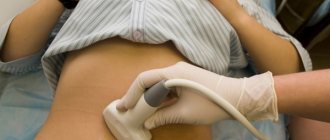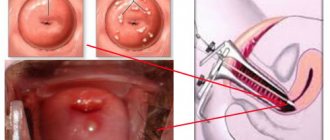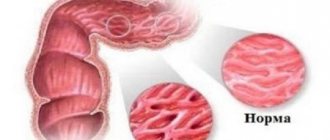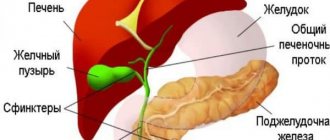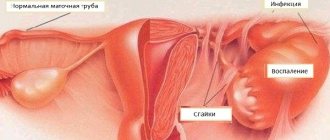Author of the article: Fedina Tatyana Leonidovna, Obstetrician-gynecologist of the highest category
Obstruction of the fallopian tubes can be caused by various reasons. One of them is the accumulation of liquid in the lumen of the pipe. In medical language, this pathological condition is called hydrosalpinx, a type of sactosalpinx, when multiple adhesions impede patency and contribute to the accumulation of exudate in the cavity. The accumulation of fluid in a closed space can cause suppuration and a sharp deterioration in the patient’s condition, posing a serious threat to her reproductive function.
Etiology of the disease
Hydrosalpinx of the tubes can develop in one or both tubes. It is possible that liquid accumulates in one chamber or the cavity is fragmented into several cells separated by partitions. An intense increase in the volume of exudate leads to swelling of the tube and the onset of the inflammatory process. The walls of the pipe become thinner, and pronounced swelling occurs. A stable inflammatory process, which is not treated with timely and competent treatment, can cause infertility or miscarriage, preventing the implantation of the embryo to the uterine wall or its full development. It is possible to influence the pathology conservatively or surgically. In the most difficult cases, the patient is indicated for tubectomy.
Classification of disease types
Depending on the distribution and nature of the disease, the following types of hydrosalpinx are distinguished:
- right- or left-sided, affecting the right or left pipe, respectively;
- bilateral, threatening a woman with complete infertility due to obstruction of the fallopian tubes;
- simple, in which only the pipe cavity is involved in the pathological process;
- follicular, in which multiple cavities are formed as adhesions grow;
- venticular, in which the contents of the fallopian tube burst into the uterine cavity and out.
Conservative treatment of hydrosalpinix
When carrying out conservative treatment of hydrosalpinx, the inflammation that caused the damage to the tubes is eliminated. It is combined with bacterial and physiotherapy. Thanks to the use of these methods of conservative treatment of hydrosalpinx, it is possible to prevent the worsening of the disease. They can be used as maintenance therapy for the formation of hydrosalpinx in a woman on the right or left. But it is impossible to eliminate the irreversible process occurring in the fallopian tubes using conservative treatment. Conservative treatment of hydrosalpinx is based on stopping the process.
- Immune activators have found active use - aloe injections, immunofan .
- Autohemotherapy can be used, in which intramuscular transfusion of one's own blood is performed.
- Secondarily, it is possible to use physiotherapeutic procedures - electrophoresis (potassium and magnesium); UHF rays; ultraviolet irradiation. Physiotherapy cannot remove adhesions formed inside the diseased organ; in this case, surgery cannot be avoided.
- If there is no adhesive pathology, then it is possible to use the methods of hydrotubation and pertubation - blowing. During hydrotubation, water is used, and in the case of pertubation, gas is used. Both processes are carried out the same way: gas or water is introduced through the uterine cavity under pressure. The doctor evaluates the sound phenomenon inside - auscultation. Water is used after the operation to identify dynamics. When carrying out treatment with hydrotubation and pertubation, it is necessary that the woman has a perfectly clean vagina, there are no infectious diseases and acute inflammatory pathologies.
- In the case of an acute form of hydrosalpinx, the doctor prescribes antibiotics, the dose and duration of treatment of which is selected based on the individual characteristics of the patient’s body.
Causes of hydrosalpinx development
The main cause of unilateral or bilateral hydrosalpinx during pregnancy or menopause, according to most medical specialists, is the consequences of prolonged inflammatory processes and numerous adhesions. The enlarged walls of the uterus prevent the full outflow of secretions produced by the mucous membrane. Also, an increase in the volume of fluid becomes possible due to its “leakage” from the cells of neighboring tissues. The adhesions formed during inflammation are located inside the oviduct or in the abdominal cavity. Their formation occurs gradually, and until the lumen is completely overgrown, the accumulated liquid may partially flow out of the cavity.
In addition to inflammatory processes, hydrosalpinx on the left or right can cause appendicitis, peritonitis, complications after surgery, endometriosis, diseases of the female genital area and STDs. There is also a possibility of developing pathology due to abortions and curettage. The inflammatory process is usually localized in the ovaries, uterine cavity or appendages. In some cases, the outflow of fluid is prevented by a benign or malignant neoplasm. The likelihood of such a development of events forces differential diagnosis to exclude oncological disease.
Surgical treatment of hydrosalpinix
If a woman needs surgical treatment of hydrosalpinx, she will first have to undergo the following examinations:
- perform general and clinical blood and urine tests;
- get tested for syphilis and hepatitis C;
- perform biochemistry.
In the absence of these tests, the surgeon cannot perform a planned operation.
LAPAROSCOPY FOR HYDROSALPINX . Laparoscopy is aimed at getting rid of adhesions that have formed in and around the tube and restoring the normal functioning of the tubular organ. But it should be borne in mind that surgery may not help in all cases. Then pregnancy naturally is impossible with hydrosalpinx. But it is possible to carry and give birth to a child using in vitro fertilization. As a rule, the tubes are removed before IVF.
HOW THE OPERATION WORKS . Laparoscopy is the most effective and advanced treatment method, in which small punctures are made in the abdominal cavity through which a laparoscope, which is a medical instrument with a camera, is inserted. An image appears on the screen in which the surgeon controls the movement of the device. Then the doctor performs manipulations aimed at eliminating the closure. The fluid is removed to avoid the possibility of an acute inflammatory process. After completion of the laparoscopic operation, the patient should spend 2 to 6 days in the hospital. For 14-20 days, a woman is not recommended to have sexual activity, undergo physical activity and eat heavy food. If pain, heavy bleeding occurs, or body temperature rises, the doctor will prescribe an additional examination.
If after laparoscopy the desired result is not achieved, then it is necessary to remove the fallopian tubes, which in a woman’s body are a source of infection and can no longer perform the functions assigned to them. Then pregnancy is possible only with the help of ART.
Symptoms of hydrosalpinx
The list of main signs of hydrosalpinx includes:
- a feeling of heaviness, nagging pain in the area of the inflammatory process during physical activity;
- copious discharge with clear or cloudy contents.
If the tube ruptures and the contents leak into the abdominal cavity, a patient with hydrosalpinx experiences sharp pain, cold sweat and increased heart rate. A possible complication is peritonitis, when bleeding occurs into the abdominal cavity followed by suppuration. The leakage of fluid from the fallopian tube does not mean the elimination of the problem: new adhesions form at the site of the rupture, and a relapse of the disease occurs.
When to see a doctor
Discomfort, nagging pain and questionable discharge that appears outside the menstrual period should be an immediate reason for a woman to consult a specialist.
Symptoms of hydrosalpinix
With hydrosalpinix, the symptoms are relatively scarce. It can be twofold and contradictory; moreover, in some cases the disease can be asymptomatic. The severity of these clinical manifestations is determined by the severity of the pathology, as well as the duration of the disease. In particular, the symptoms of hydrosalpinix include the appearance of weakness, increased body temperature, and the occurrence of nagging pain in the lower abdomen. The pain may also be pulsating or bursting in nature. There is a possibility of developing tachycardia against the background of this manifestation. In addition, a symptom of hydrosalpinix is infertility.
Ventilal hydrosalpinx is characterized by the systematic appearance of copious watery discharge from the genital tract.
Diagnosis of hydrosalpinx
In the early stages, only high-precision instrumental research methods can diagnose the disease. Later, when the pathology becomes more pronounced, it is possible to see the inflammation of the tube during a routine gynecological examination. The form of the disease can be determined by:
- smear examination of discharge;
- Ultrasound diagnosis of hydrosalpinx using the vaginal or abdominal method;
- diagnostic laparoscopy;
- hysterosalpingography, which studies the condition and patency of the fallopian tubes, as well as clarifying the possible development of a neoplasm in the uterine area.
The advantages of the laparoscopic method are the combination of diagnosis and treatment of the disease. During examination, it is possible to dissect adhesions and apply a stoma for effective drainage of fluid. Conservative treatment can eliminate the consequences of pathology.
Diagnosis of hydrosalpinix
Diagnosis of hydrosalpinix consists of several stages:
- conducting a gynecological examination, during which it is possible to determine a tightly elastic formation, which has an ovoid or round shape, between the ovary and the uterus. As a rule, it is painless or slightly painful;
- performing an ultrasound, through which it is possible to determine the presence of fluid formation between the ovaries and the uterus;
- carrying out hysterosalpingography;
- performing laparoscopy.
In addition, the doctor pays attention to the analysis of the medical history and complaints, obstetric and gynecological history.
Treatment of hydrosalpinx
At the initial stage of treatment, a patient with hydrosalpinx is sent for surgery to remove inflammation, restore patency of the tubes and their normal functioning. The laparoscopic method is considered optimal for most patients. Its low morbidity is explained by the use of endoscopic equipment, which does not require deep incisions and eliminates tissue damage. A few hours after recovering from anesthesia, the patient can get up and move around with the help of loved ones. The effect of the treatment can be supplemented by:
- a conservative course, which involves taking antibiotics, anti-inflammatory drugs and drugs for resolving adhesions;
- methods of physiotherapy: electrophoresis, magnetic therapy, mud therapy, balneotherapy, electrical stimulation of pipes, etc.
Complete restoration of tube patency is considered impossible, since hydrosalpinx is recurrent. This increases the risk of ectopic pregnancy, which is dangerous for the mother and the fetus. If the patient does not plan to conceive and give birth to a child, a tubectomy is indicated so that the inflamed tissue does not become a source of infection for the entire body.
Hydrosalpinx and pregnancy
According to statistical data, the probability of pregnancy with this pathology is reduced by at least two times, and the number of cases of ectopic pregnancy and spontaneous termination of pregnancy (miscarriages) increases by the same amount.
Due to the widespread use of in vitro fertilization (IVF), many reports have emerged indicating a significant number of cases of failure of the procedure in women with this disease. The frequency of implantation of a fertilized egg, embryo development and pregnancy is 2-5 times lower in them compared to women with other causes of infertility. Moreover, the degree of negative IVF results generally depends little on the methods of assisted reproductive technologies (ART).
In addition, some authors consider ART to be one of the risk factors for the development of ectopic pregnancy. However, the frequency of this complication after IVF associated with hydrosalpings is the same as with other tubal pathology. What is fundamental in these cases is the presence of the very fact of damage to the oviducts, regardless of the particular variant. So why is hydrosalpinx dangerous during IVF, as well as during natural conception and during pregnancy in general?
How to enroll in JSC "Medicine" (clinic of academician Roitberg)
You can make an appointment with the specialists of JSC "Medicine" (clinic of Academician Roitberg) on the website - the interactive form allows you to select a doctor by specialization or search for an employee of any department by name and surname. Each doctor’s schedule contains information about visiting days and hours available for patient visits.
Clinic administrators are ready to accept requests for an appointment or call a doctor at home by phone.
Convenient location on the territory of the central administrative district of Moscow (CAO) - 2nd Tverskoy-Yamskaya lane, building 10 - allows you to quickly reach the clinic from the Mayakovskaya, Novoslobodskaya, Tverskaya, Chekhovskaya and Belorusskaya metro stations .
What is hydrosalpinx?
Hydrosalpinx is a disease that occurs as a complication after inflammation of the appendages. It is considered quite dangerous and often leads to infertility. The pathology is the accumulation of fluid in the cavity of the fallopian tubes. In many cases, the problem is asymptomatic and is detected when a woman undergoes examination due to existing infertility. Diagnosis is carried out using instrumental methods, and treatment usually requires surgical intervention.
Serous effusion accumulates in the fallopian tubes and disrupts their patency. Every year the problem occurs more often and causes miscarriage, non-implantation of the embryo and ectopic cases of implantation of a fertilized egg.
The pathology may appear in one of the fallopian tubes or have a bilateral localization. The contents of the cavity are serous fluid or pus.
Depending on the number of pathological formations, simple and multilocular hydrosalpinx are distinguished. The second type is diagnosed when there are several cavities. Their sizes can reach several centimeters. The ventilatory form of the disease is when the cavity bursts and the contents come out through the uterus and vagina. The woman feels acute pain and notices watery discharge. When the fluid accumulates in small quantities, the discomfort may not be severe.
The disease has an acute and chronic course. In the first case, the symptoms are pronounced, in the second they are blurred and nonspecific.
Complications and consequences: can a pipe burst, does dysbacteriosis develop, when is IVF necessary?
With proper and timely treatment, the prognosis for a woman’s health is favorable. If the process is neglected and therapy is refused, complications may arise, such as suppuration of the fallopian tube or its rupture, which contributes to the occurrence of peritonitis or sepsis. Hydrosalpinx also affects the menstrual cycle, leading to its disruption (it becomes irregular, menstruation is accompanied by severe pain in the lower abdomen). Pathology cannot cause dysbacteriosis, since it itself occurs against the background of microflora disturbance.
No matter how sad it may sound, hydrosalpinx almost always leads to tubal infertility. But still, even if there is one healthy fallopian tube, pregnancy is possible. With a bilateral pathological process, these chances are zero. Therefore, in most cases, such patients are indicated for the procedure of in vitro fertilization.
How to treat hydrosalpinx: can the disease go away on its own?
Many women mistakenly believe that a pathology such as hydrosalpinx is not dangerous, especially if they are not bothered by unpleasant symptoms. But an untreated process can forever make it impossible to conceive a child naturally. In addition, an enlarged fallopian tube may rupture as a result of overstretching of the walls with liquid contents, which is dangerous for the patient’s life.
The disease cannot go away on its own, so it is necessary to begin treatment as quickly as possible to avoid dire consequences.
Conservative therapy: antibiotics, vitamins, tampons with Vishnevsky ointment and other means
Unfortunately, hydrosalpinx cannot be completely cured conservatively, especially if the process is in an acute or advanced stage. Of course, drug therapy is more preferable compared to surgical treatment, but it is not as effective.
Treatment
Today, doctors offer two methods of treating hydrosalpinx - conservative and surgical. Both of them are aimed at resolving the fluid accumulated in the pipes and, ultimately, restoring their normal patency.
Conservative method
The initial stage of the conservative method, as a rule, involves eliminating the inflammation that led to the appearance of hydrosalpinx. In addition, antibacterial and physical therapy are prescribed. In principle, such treatment has an effect only when the cause of hydrosalpinx is the previously mentioned diseases salpingitis, salpingoophoritis and adnexitis.
Thus, conservative treatment effectively affects the inflammatory process and is powerless in the fight against adhesions and scars. And methods such as microenemas from decoctions of sage, chamomile, St. John's wort, which traditional medicine advises, are only supportive methods of therapy and do not lead to a cure.
Operative method
The surgical method of treating hydrosalpinx, namely laparoscopy, is recognized as a radical and truly positive result. The surgeon performs plasty of the fallopian tubes, removing adhesions and expanding the lumen. In especially severe cases, when it is obvious that plastic surgery will not restore the functionality of the fallopian tubes, they are removed, since they represent a source of chronic infection.
Traditional methods of hydrosalpinx
Many women, when they have completely lost faith, begin to use traditional methods of treatment. Indeed, it is necessary to try all treatment methods. Traditional healers offer the following popular recipes:
- Baths with the addition of juniper. You will need to take 70 grams of a mixture of dry plant stems and berries. Pour boiling water (10 liters) over the collection. Leave the broth for about 3 hours, then strain. The product is added to the bath. You need to take it no more than half an hour.
- Cabbage steam bath is an ancient remedy. It is necessary to make a chair that will have a hole in the bottom. Place a container with steamed cabbage leaves under the chair. The woman should sit down so that the open healing steam flows over her genitals. The procedure helps relieve pain and stops the inflammatory process.
- Douching with herbal decoctions (oak bark, cinquefoil root, chamomile, mallow flowers). To prepare the solution, you need to take 2 tablespoons of herbs and pour 200 ml of boiling water. This treatment method alleviates the symptoms of hydrosalpinx.
Thus, a woman who wants to become pregnant must carefully monitor her health. It is important to visit a gynecologist for preventive purposes and promptly treat various inflammatory processes of the reproductive organs.
Is it possible to get pregnant with hydrosalpinx?
Natural pregnancy with active hydrosalpinx is almost impossible, but there is still a chance, albeit insignificant. Whether a woman becomes pregnant or not will depend on certain factors, including:
- duration of illness . If there was liquid in the tubes for a long time, it could damage the fimbriae that are involved in the process of conception. The longer the patient delays treatment, the less chance of natural conception;
- severity of the disease . If the inflammation is very severe and affects the endometrium and ovaries, it will not be easy to get pregnant;
- localization of adhesions . If hydrosalpinx has affected only one fallopian tube, you can become pregnant naturally with one (healthy, without adhesions or inflammation) fallopian tube, although the chances are naturally lower than with two.
The health status of the sexual partner is also important. Nowadays, a fairly large number of men are susceptible to decreased reproductive efficiency without knowing it. When planning to conceive, men are advised to have a spermogram.
If you have hydrosalpinx, you can get pregnant, but only if the second fallopian tube is healthy. Some women often refuse treatment for hydrosalpinx, hoping that pregnancy will happen anyway.
Doctors always insist on immediate treatment, because even with hydrosalpinx on one fallopian tube, an ectopic pregnancy can develop. If conception occurs in a damaged fallopian tube, the embryo may begin to develop there without being able to exit into the uterus.
Hydrosalpinx on one side
If only one fallopian tube is affected, no matter which side, doctors recommend starting to plan conception only after final treatment and a period of rehabilitation. If the damaged tube is removed, the chances of conception will increase. Various risks and probabilities of complications during pregnancy characteristic of hydrosalpinx will also be reduced.
Damage to fimbriae
After ovulation, the egg should go straight into the fallopian tube. Fimbriae (special hairs at the entrance to the pipe) should help her with this. They capture the egg and send it into the fallopian tube, where it should meet sperm. If hydrosalpinx develops, these villi can stick together. This leads to their subsequent atrophy.
This is what fimbriae look like. With hydrosalpinx, they can become damaged and never recover.
It is impossible to restore the functionality of the fimbriae. Yes, during laparoscopy you can restore the fallopian tube (do plastic surgery). This will restore patency, but in the absence of properly functioning fimbriae it is impossible to guarantee conception. Doctors believe that if the fimbriae are damaged (glued together), it will not be possible to become pregnant naturally, even with complete patency of the fallopian tubes. With hydrosalpinx on both sides, there is only one way out - IVF after laparoscopy.
In Vitro Fertilization
Because of the low chance of success when attempting surgical tubal repair (some studies report that only 10% of women with hydrosalpinx achieve pregnancy after neosalpingostomy), and because of the increased risk of developing an ectopic pregnancy, most women with severely damaged fallopian tubes In vitro fertilization is recommended.
If in vitro fertilization is performed before surgery to remove the fallopian tubes, then the chances of its success will be low. Therefore, doctors often recommend that patients first undergo a salpingectomy and only then proceed with in vitro fertilization treatment. In such situations, a woman will have a significantly higher chance of successfully conceiving.
Types and symptoms
The first division of hydrosalpinx into types is based on the number of cavities in the fallopian tube:
- simple form - one cavity is formed
- follicular form - several cavities are formed
There are also forms of the disease that correlate with its course:
Having decided on the forms, it would be logical to move on to their symptoms. Acute is characterized by:
- production of serous exudate
- temperature increase
- weakness
- cardiopalmus
- throbbing pain in the groin area
- pronounced blush on the cheeks, which is not typical on ordinary days
The chronic form develops slowly and over a long period of time, so there is no pain or other tangible signs, and the disease itself can only be detected with a pelvic ultrasound. If a lot of mucus has accumulated in the tubes, then the woman may feel a foreign body and heaviness in the groin area, and pelvic pain is possible.
There is another type of disease that is impossible to ignore - ventral hydrosalpinx. The adhesions in the fallopian tubes in this form have a loose structure and periodically break through, pouring out streams of mucus. A natural symptom of the disease is copious watery discharge.
Well, we’ve sorted out the forms, let’s move on to methods for diagnosing hydrosalpinx.
Why is hydrosalpinx dangerous?
The disease disrupts the functioning of the fallopian tubes, destroys the mucous membrane, and slowly but surely leads to ectopic pregnancy or infertility. Without timely treatment, fluid accumulates between the adhesions, and a dangerous source of infection is constantly present in the woman’s body. This is a negative fact for the IVF procedure, which doctors resort to if infertility from hydrosalpinx cannot be avoided.
Be attentive and careful about your own health and do not exclude the joy of motherhood due to laziness or stupid delay in visiting the gynecologist.
The diagnosis of hydrosalpinx often becomes an obstacle to a successful pregnancy and even to in vitro fertilization. Meanwhile, not all women like the proposal to cut out the fallopian tube because of this. Why cut out something that doesn’t hurt and, generally speaking, doesn’t really bother you? To cut or not to cut – let’s figure it out together.
Prevention of disease occurrence
Prevention of hydrosalpinx comes down to preventing and eliminating the causes that cause it:
- it is necessary to undergo regular examination by a gynecologist (at least twice a year);
- timely diagnose and treat inflammatory and infectious processes of the genital area;
- observe the rules of intimate hygiene daily;
- It is advisable to have one sexual partner (if this is not possible, use barrier contraception - condoms, vaginal caps, etc.).
Hydrosalpinx directly affects the main function of the female body - conception and childbirth. Therefore, it is better to prevent a disease than to treat it.
Hydrosalpinx is not as harmless a disease as it seems. But many years of practice of gynecologists, reproductive specialists and surgeons shows that timely detection and treatment of this problem can help avoid further complications.





